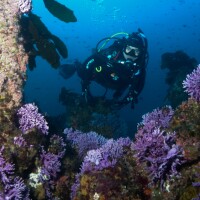Obama Expands California Coastal National Monument


In what some environmental groups are calling a “parting gift” to Californians, President Barack Obama today added 6,230 acres to the California Coastal National Monument.
The monument, established in 2000 by former President Bill Clinton, protects islands, offshore rocks, and reefs in a 12-mile band along the length of the California coast, as well as 1,665 onshore acres at the mouth of the Garcia River in Mendocino County added in 2014.
Today’s proclamation by President Obama, a use of the power granted him by the 1906 Antiquities Act, nearly quadruples the land area of the monument by adding five onshore parcels in Northern California, along with a number of rocks and islands off the Orange County coastline that were omitted from the original designation due to a conflicting federal law passed in 1931.
The expansion comes in tandem with a 48,000-acre expansion of the Cascade-Siskiyou National Monument, which extends that Monument into a 5,000-acre portion of extreme Northern California, and the designation of three National Monuments in the Southeast, one in South Carolina and two in Alabama, preserving historic sites important to the Civil Rights movement from Reconstruction to the modern era.
“The BLM manages some of the nation's wildest and most sacred landscapes, including more than 800 areas that have been protected through congressional and presidential action. We're proud to be charged with stewarding these incredible lands for future generations, including today’s additions to the Cascade-Siskiyou National Monument and the California Coastal National Monument,” said Bureau of Land Management Director Neil Kornze. “The BLM looks forward to continuing and expanding our work with local communities to ensure successful management of these special places.”
The historic Monuments designated today are the Birmingham Civil Rights National Monument, commemorating the activism of Martin Luther King, Jr. and his colleagues in that city; the Freedom Riders National Monument, which marks the site in Anniston, Alabama where vigilantes attempted to kill a busload of civil rights activists on Mothers’ Day, 1961; and the Reconstruction Era National Monument in Beaufort County, South Carolina, site of the so-called “Port Royal Experiment” in which the Lincoln Administration attempted to guide newly freed slaves to self-sufficient living.
The sole Southern California component of the expansion of the California Coastal National Monument involves the offshore rocks in Orange County, which were omitted from the original designation in 2000. Those rocks were “withdrawn” as public lands by Congress in 1931 in an attempt to preserve them from private commercial exploitation. That preservation worked, and the rocks remain important roosts for seabirds and haul-out spots for marine mammals. Today’s designation rescinds that 1931 withdrawal and folds the rocks into the National Monument, where they join at least 20,000 other rocks, reefs, and tiny islands off the California coast.
The southernmost onshore addition designated in today’s proclamation is 20 acres in San Luis Obispo County at the Piedras Blancas light station, previously an Outstanding Natural Area managed by the Bureau of Land Management

By far the largest addition to the Monument is a 5,780-acre expanse of public land near Davenport in Santa Cruz County called the Cotoni-Coast Dairies Public Lands. This addition, which includes portions of six coastal watersheds and encompasses coastal prairie, redwood forest, and riparian canyons, is more than twice the size of the entire remaining monument holdings combined.
The remaining additions, all in Humboldt County, are the 440-acres Lost Coast Headlands parcel, 13 acres at Trinidad Head, and the eight-acre Lighthouse Ranch tract. All the lands added to the California Coastal National Monument today were previously federal land with stringent protection measures in place; the designation does not affect any private land. All were included in a 2016 bill by Senator Barbara Boxer that would have expanded the Monument by legislative means.
“These national monument expansions are an investment in our environment and an acknowledgement that healthy communities need access to nature and outdoor activity. Our shared lands and waters sustain the remarkable quality of life and economy of the West. We are grateful to President Obama and the forward-thinking members of Congress who advocated for protecting these national treasures,” said Dan Smuts, Senior Director – Pacific Region of The Wilderness Society.





